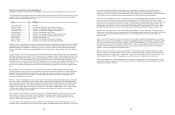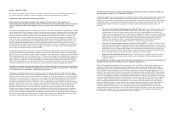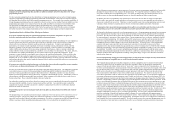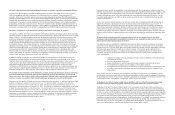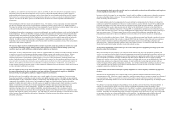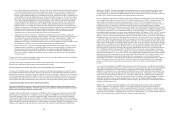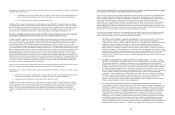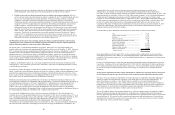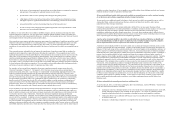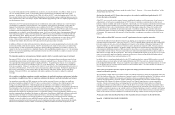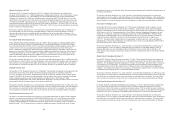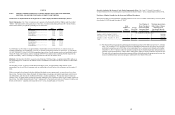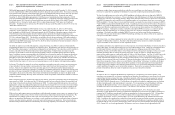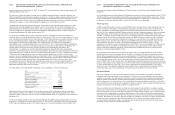Dish Network 2012 Annual Report Download - page 25
Download and view the complete annual report
Please find page 25 of the 2012 Dish Network annual report below. You can navigate through the pages in the report by either clicking on the pages listed below, or by using the keyword search tool below to find specific information within the annual report.38
38
x the diversion of our management’s attention from our existing business to integrate the operations
and personnel of the acquired or combined business or joint venture;
x possible adverse effects on our operating results during the integration process;
x a high degree of risk involved in these transactions, which could become substantial over time,
and higher exposure to significant financial losses if the underlying ventures are not successful;
x our possible inability to achieve the intended objectives of the transaction; and
x the risks associated with complying with regulations applicable to the acquired business, which
may cause us to incur substantial expenses.
In addition, we may not be able to successfully or profitably integrate, operate, maintain and manage our newly
acquired operations or employees. We may not be able to maintain uniform standards, controls, procedures and
policies, and this may lead to operational inefficiencies. In addition, the integration process may strain our financial
and managerial controls and reporting systems and procedures.
New acquisitions, joint ventures and other transactions may require the commitment of significant capital that would
otherwise be directed to investments in our existing businesses. Commitment of this capital may cause us to defer
or suspend any share repurchases that we otherwise may have made. To pursue acquisitions and other strategic
transactions, we may need to raise additional capital in the future, which may not be available on acceptable terms or
at all.
These transactions pose substantial risks and require the commitment of significant capital both to complete the
acquisitions and to operate the acquired businesses following their acquisition. These acquisitions may result in
significant financial losses if the intended objectives of the transactions are not achieved, and we may lose up to the
entire value of our investment in these acquisitions and transactions. Some of the businesses acquired by us have
experienced significant operating and financial challenges in their recent history, which in some cases resulted in
these businesses commencing bankruptcy proceedings prior to our acquisition. We may acquire similar businesses
in the future. There is no assurance that we will be able to successfully address the challenges and risks encountered
by these businesses following their acquisition. If we are unable to successfully address these challenges and risks,
our business, financial condition or results of operations may likely suffer.
For example, we have recently been engaged in discussions regarding a potential strategic transaction with
Clearwire Corporation (“Clearwire”). On January 8, 2013, Clearwire issued a press release summarizing the
proposed transaction at that time. Later that day, we confirmed that we had formally approached Clearwire with
respect to a potential strategic transaction on the terms and conditions generally outlined in Clearwire’s press
release. The terms and conditions for a potential strategic transaction at that time disclosed by Clearwire generally
provided for the following, among others: (i) we would acquire approximately 24% of Clearwire’s total spectrum,
for approximately $2.2 billion; and (ii) we would make an offer to purchase up to all of Clearwire’s outstanding
shares at a price of $3.30 per share in cash. This offer would be subject to certain conditions, including that we
acquire no less than 25% of the fully-diluted shares of Clearwire and receive certain governance and minority
protection rights. There is no assurance that we will continue discussions with Clearwire or that we will ultimately
be able to conclude a transaction with Clearwire upon the terms outlined above or at all.
To the extent that we are able to conclude a transaction with Clearwire, we may be required to commit a significant
portion of our cash and marketable securities to fund these arrangements, and these commitments may cause us to
defer or curtail investments in our core business, strategic investments, share repurchases or other transactions that
we otherwise may have made. Furthermore, Clearwire has experienced significant operating and financial
challenges in its recent history. Therefore, any investment we may make in Clearwire will be speculative, and we
may lose all of the investment. In addition, we may be required to spend additional capital or raise additional capital
to support an investment in Clearwire’s business and to build out a network to utilize the spectrum acquired, which
may not be available on acceptable terms or at all. There can be no assurance that we will be able to develop and
implement a business model that will realize a return on a possible transaction with Clearwire or that we will be able
to profitably deploy the spectrum assets, which may affect the carrying value of these assets and our future financial
39
39
condition or results of operations. If we are unable to successfully address these challenges and risks, our business,
financial condition or results of operations will likely suffer.
We may need additional capital, which may not be available on acceptable terms or at all, to continue investing
in our businesses and to finance acquisitions and other strategic transactions.
We may need to raise additional capital in the future, which may not be available on acceptable terms or at all, to
among other things, continue investing in our business, construct and launch new satellites, and to pursue
acquisitions and other strategic transactions.
Furthermore, weakness in the equity markets could make it difficult for us to raise equity financing without
incurring substantial dilution to our existing shareholders. In addition, sustained economic weakness or weak results
of operations may limit our ability to generate sufficient internal cash to fund these investments, capital
expenditures, acquisitions and other strategic transactions. As a result, these conditions make it difficult for us to
accurately forecast and plan future business activities because we may not have access to funding sources necessary
for us to pursue organic and strategic business development opportunities.
A portion of our investment portfolio is invested in securities that have experienced limited or no liquidity and
may not be immediately accessible to support our financing needs, including investments in public companies
that are highly speculative and have experienced and continue to experience volatility.
A portion of our investment portfolio is invested in auction rate securities and strategic investments, and as a result,
a portion of our portfolio has restricted liquidity. Liquidity in the markets for these investments has been adversely
impacted. If the credit ratings of these securities deteriorate or the lack of liquidity in the marketplace continues, we
may be required to record further impairment charges. Moreover, the sustained uncertainty of domestic and global
financial markets has greatly affected the volatility and value of our marketable investment securities. In addition, a
portion of our investment portfolio includes strategic and financial investments in debt and equity securities of
public companies that are highly speculative and have experienced and continue to experience volatility. Typically,
these investments are concentrated in a small number of companies. The fair value of these investments can be
significantly impacted by the risk of adverse changes in securities markets generally, as well as risks related to the
performance of the companies whose securities we have invested in, risks associated with specific industries, and
other factors. These investments are subject to significant fluctuations in fair value due to the volatility of the
securities markets and of the underlying businesses. The concentration of these investments as a percentage of our
overall investment portfolio fluctuates from time to time based on, among other things, the size of our investment
portfolio and our ability to liquidate these investments. In addition, because our portfolio may be concentrated in a
limited number of companies, we may experience a significant loss if any of these companies, among other things,
defaults on its obligations, performs poorly, does not generate adequate cash flow to fund its operations, is unable
to obtain necessary financing on acceptable terms, or at all, or files for bankruptcy, or if the sectors in which these
companies operate experience a market downturn. To the extent we require access to funds, we may need to sell
these securities under unfavorable market conditions, record further impairment charges and fall short of our
financing needs.
We have substantial debt outstanding and may incur additional debt.
As of December 31, 2012, our total debt, including the debt of our subsidiaries, was $11.888 billion. Our debt levels
could have significant consequences, including:
x requiring us to devote a substantial portion of our cash to make interest and principal payments on our debt,
thereby reducing the amount of cash available for other purposes. As a result, we would have limited
financial and operating flexibility in responding to changing economic and competitive conditions;
x limiting our ability to raise additional debt because it may be more difficult for us to obtain debt financing
on attractive terms; and
x placing us at a disadvantage compared to our competitors that are less leveraged.



